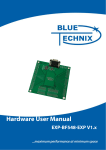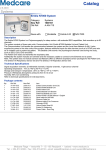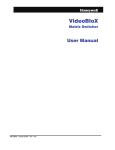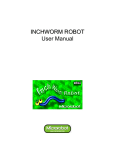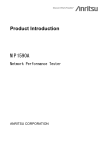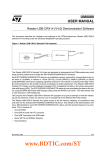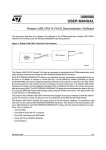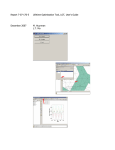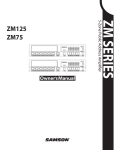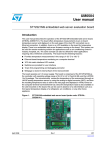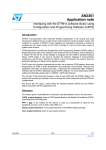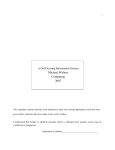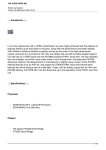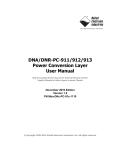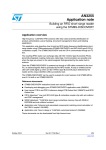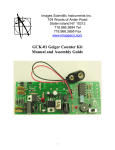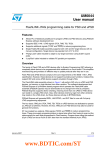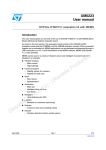Download Short-range RFID reader with autonomous functions
Transcript
UM0230 User manual Short-range RFID reader with autonomous functions This User manual describes the hardware and software of the demokit for the STMicroelectronics short-range RFID reader with Autonomous functions. The demokit runs under the Windows 98, Windows 2000 and Windows XP operating systems. The purpose of this demokit is to demonstrate the key features of the STMicroelectronics Short Range RFID family. All products in the family meet global security and cost requirements by complying with the worldwide ISO 14443-B standard and free licensing policy. This particular demokit can be powered in several ways, has a USB and an RS232 interface, and offers PC and autonomous operating modes. Owing to this diversity and flexibility, it is easier for the customer to further develop the system according to his needs. All the design source data are delivered with the kit, ready to be reused in further developments. The target applications for this demokit are data collection, access control, medical, traceability, brand protection, e-purse and vending machines. Figure 1. April 2006 Demokit hardware for a short-range RFID reader with autonomous functions Rev 1 1/19 www.st.com Contents UM0230 - User manual Contents 1 2 3 Demokit overview . . . . . . . . . . . . . . . . . . . . . . . . . . . . . . . . . . . . . . . . . . . 5 1.1 RFID Short Range products . . . . . . . . . . . . . . . . . . . . . . . . . . . . . . . . . . . . 5 1.2 µPSD3422EV Turbo Plus Series product . . . . . . . . . . . . . . . . . . . . . . . . . . 5 1.3 M41T65 (RTC) Serial Real-Time Clock product . . . . . . . . . . . . . . . . . . . . . 5 Getting started . . . . . . . . . . . . . . . . . . . . . . . . . . . . . . . . . . . . . . . . . . . . . . 7 2.1 Software installation . . . . . . . . . . . . . . . . . . . . . . . . . . . . . . . . . . . . . . . . . . 7 2.2 Physical connections . . . . . . . . . . . . . . . . . . . . . . . . . . . . . . . . . . . . . . . . . 9 2.3 Launching the short-range RFID reader dashboard software . . . . . . . . . 10 Short-range reader . . . . . . . . . . . . . . . . . . . . . . . . . . . . . . . . . . . . . . . . . 11 3.1 Memory records . . . . . . . . . . . . . . . . . . . . . . . . . . . . . . . . . . . . . . . . . . . . 12 3.2 Control board description . . . . . . . . . . . . . . . . . . . . . . . . . . . . . . . . . . . . . 12 4 Win32 Dashboard Control . . . . . . . . . . . . . . . . . . . . . . . . . . . . . . . . . . . 14 5 HyperTerminal Control . . . . . . . . . . . . . . . . . . . . . . . . . . . . . . . . . . . . . . 15 Appendix A Schematic diagrams . . . . . . . . . . . . . . . . . . . . . . . . . . . . . . . . . . . . . 16 6 References . . . . . . . . . . . . . . . . . . . . . . . . . . . . . . . . . . . . . . . . . . . . . . . . 18 7 Revision history . . . . . . . . . . . . . . . . . . . . . . . . . . . . . . . . . . . . . . . . . . . 18 2/19 UM0230 - User manual List of tables List of tables Table 1. Table 2. Table 3. Table 4. Table 5. Event record structure . . . . . . . . . . . . . . . . . . . . . . . . . . . . . . . . . . . . . . . . . . . . . . . . . . . . 12 Status Byte . . . . . . . . . . . . . . . . . . . . . . . . . . . . . . . . . . . . . . . . . . . . . . . . . . . . . . . . . . . . . 12 Onboard LED description . . . . . . . . . . . . . . . . . . . . . . . . . . . . . . . . . . . . . . . . . . . . . . . . . . 12 RS232 interface commands . . . . . . . . . . . . . . . . . . . . . . . . . . . . . . . . . . . . . . . . . . . . . . . . 15 Document revision history . . . . . . . . . . . . . . . . . . . . . . . . . . . . . . . . . . . . . . . . . . . . . . . . . 18 3/19 List of figures UM0230 - User manual List of figures Figure 1. Figure 2. Figure 3. Figure 4. Figure 5. Figure 6. Figure 7. Figure 8. Figure 9. Figure 10. Figure 11. 4/19 Demokit hardware for a short-range RFID reader with autonomous functions . . . . . . . . . . 1 Welcome window . . . . . . . . . . . . . . . . . . . . . . . . . . . . . . . . . . . . . . . . . . . . . . . . . . . . . . . . . 7 Choose Destination Location window . . . . . . . . . . . . . . . . . . . . . . . . . . . . . . . . . . . . . . . . . . 8 Connecting the Short-Range RFID reader . . . . . . . . . . . . . . . . . . . . . . . . . . . . . . . . . . . . . . 9 Dashboard Main Window . . . . . . . . . . . . . . . . . . . . . . . . . . . . . . . . . . . . . . . . . . . . . . . . . . 10 HyperTerminal . . . . . . . . . . . . . . . . . . . . . . . . . . . . . . . . . . . . . . . . . . . . . . . . . . . . . . . . . . 10 HyperTerminal settings . . . . . . . . . . . . . . . . . . . . . . . . . . . . . . . . . . . . . . . . . . . . . . . . . . . . 10 Control board description . . . . . . . . . . . . . . . . . . . . . . . . . . . . . . . . . . . . . . . . . . . . . . . . . . 13 Description of the main Dashboard window . . . . . . . . . . . . . . . . . . . . . . . . . . . . . . . . . . . . 14 Control board schematics . . . . . . . . . . . . . . . . . . . . . . . . . . . . . . . . . . . . . . . . . . . . . . . . . . 16 Antenna board schematics . . . . . . . . . . . . . . . . . . . . . . . . . . . . . . . . . . . . . . . . . . . . . . . . . 17 UM0230 - User manual 1 Demokit overview Demokit overview The demokit tools for short-range RFID readers with Autonomous functions are designed to demonstrate several STMicroelectronics products (see Section 6: References): RFID Short Range, Turbo Plus Series and Serial Real-Time Clock products. 1.1 RFID Short Range products These STMicroelectronics products include the CRX14 and CR14 readers, and several contactless memories/tag products: SRI4K, SRIX4K, SRIX512. All the contactless memories are powered by a transmitted carrier radio wave at 13.56MHz and are compliant with the ISO 14443-B recommendation for the transfer of power and signals via radio transmission. The Short Range CRX14 / CR14 RFID reader circuitry amplitude modulates (10% modulation) the data on the carrier using amplitude shift keying (ASK) and the tag replies by load modulating the data on the carrier using the BPSK (Bit Phase Shift Keying) of a 847kHz subcarrier. The data transfer rate in each direction is 106 Kbit/second. 1.2 µPSD3422EV Turbo Plus Series product The µPSD3422EV belongs to the popular µPSD family of 8051-class embedded Flash microcontrollers that offers system-level-integration with world-leading Flash memory and SRAM densities (up to 256-KBytes and 32-KBytes, respectively) for general-purpose 8-bit embedded applications. The µPSD3422EV Turbo Plus series performs up to 10 MIPS peak and provides full-speed USB. A JTAG interface supports in-system programming and MCU core debug with highspeed instruction tracing capability, eliminating the need for a hardware In-Circuit Emulator (ICE). Other peripherals include a 16-bit Programmable Counter Array (PCA), an 8-channel, 10-bit resolution analog-to-digital converter, SPI and IrDA interfaces, six PWM (pulse-width modulated) channels, an I²C (Intelligent Interface Controller) master/slave bus controller, two standard UARTs (Universal Asynchronous Receiver/Transmitter), supervisory functions such as a watchdog timer and low-voltage detect, and up to 45 general-purpose I/O pins. 1.3 M41T65 (RTC) Serial Real-Time Clock product The M41T65 (RTC) is used in a broad range of applications. It is available in a lead-free 16pin QFN package (just 3mm²) and is designed for a bus operating voltage from 3.6V down to 1.3V, but will maintain timekeeping at supply levels as low as 1.0V, thus providing more robust system performance. Operating current is only 350µA on a 3.0V supply, making the RTCs ideal for battery operation and handheld applications. M41T65 operates over the industrial temperature range of –40 to +85° C. 5/19 Demokit overview UM0230 - User manual The kit consists of: ● Circuit boards – Control board with µPSD3422EV and Boosted antenna board ● USB cable ● I2C cable ● Some transponder samples (of the SRIX4K) ● CD with control software, related user manual, application notes and datasheets. Application features: 6/19 ● RAM: 32 Mbit ● HDD free space: 5MB ● USB version 1.1 ● Runs on the Windows 98 SE Platform, Windows 2000, Windows XP UM0230 - User manual Getting started 2 Getting started 2.1 Software installation ● First insert the CD supplied by STMicroelectronics in your CD drive. ● The auto run will bring up the CD content. Install the Win32 Dashboard software from the Reader software section. ● After opening the folder, run the setup.exe program. ● Read the text of the Welcome window (Figure 2), and then click on “Next”. Figure 2. Welcome window 7/19 Getting started ● UM0230 - User manual Choose your destination location as shown in Figure 3, then click on “Next”. The default folder is C:\Program Files\STMicroelectronics\RFID_DashBoard Figure 3. 8/19 Choose Destination Location window UM0230 - User manual 2.2 Getting started Physical connections The short-range RFID reader can be connected in different ways as shown in Figure 4. To proceed to the connection do as follows: Caution: ● Connect the boosted Antenna board to the Control board using the supplied 4-wire ribbon cable. ● Connect the Control board to your PC/Laptop using the supplied USB cable and let Windows recognize the HID class device (no user action needed). Optionally you can connect the Control board to your PC/Laptop using the RS232 interface. ● In case you plan to use some of the autonomous functions you can connect a 9V battery or an external DC power supply (6V to 12V). Disconnect the battery when it is not being used! Figure 4. Connecting the Short-Range RFID reader Antenna Board RS232 USB Control Board I²C 6V-12V 9V battery DC power supply – + ai12808 9/19 Getting started 2.3 UM0230 - User manual Launching the short-range RFID reader dashboard software In the Start menu, click on Programs and select Reader’s Win32 Dashboard to launch the dashboard software. The Dashboard Main Window shown in Figure 5 appears. Figure 5. Dashboard Main Window It is also possible to partially control the demokit via UART. To do so, start Windows HyperTerminal (Figure 6) and set up the port settings according to the screenshot shown on the right-hand-side figure (Figure 7). The UART communication speed is of 9600kbs, 8 data bits with no parity and 1 stop bit. Figure 6. 10/19 HyperTerminal Figure 7. HyperTerminal settings UM0230 - User manual 3 Short-range reader Short-range reader The reader has two main modes of operation: ● CRX14USB Demokit Mode ● Autonomous Mode In the CRX14USB Demokit Mode, the reader behaves exactly in the same way as in the CRX14USB Demokit (see the UM0080 User manual) and is fully compatible with the CRX14Demokit software. In the Autonomous Mode, the PC can send a macro-command to the reader via the USB or the RS232 cable, and the reader can then execute it without any further need of the PC. There are two Autonomous Mode sub-functions: AutoRead and AutoWrite. ● In the AutoRead cycle: after a “Start” (from either the push button or the PC), the onboard reader reads the UID of whatever tag (STMicroelectronics Short Range family) comes into the antenna field, and deals with the ASCII User Data (either read (AutoRead) or write operations (AutoWrite)). Every event is logged as a record in the Flash memory of the µPSD. ● In the AutoWrite cycle: first the reader has to memorize the user phrase, then, after a “Start” (from the push button or the PC), the reader always writes the same ASCII phrase to the User Data area of whatever tag (STMicroelectronics Short Range family) that comes into the antenna field. The rest of the User Data is filled with blanks. Successful read and write operations are indicated by the flashing of Green LED 1. The cycles have to be ended by a “Stop” (from either the push button or the PC). The only case where a cycle will end automatically is when the Flash memory space is full (full FLASH detected). Once the operation is stopped, the stored data can be downloaded to the PC through a USB or UART macro-command. If the Autonomous reader cycle is stopped the whole Flash memory record storage space can be erased via another macro-command. Switching between the CRX14USB Demokit Mode and the Autonomous Mode can be done either through a software command from the PC or by pressing and holding the onboard button (SW1) for a few seconds. 11/19 Short-range reader 3.1 UM0230 - User manual Memory records Autonomous Events are all being stored in the Flash memory space of the onboard microcontroller. To minimize and simplify Flash memory management, a simple principle of incremental write of records with fixed length (32 Bytes) is used. The structure of an event record is described in Table 1. Table 1. Event record structure Name Offset [Bytes] Length [Bytes] Header 0 1 Header of the record Status Byte 1 1 Status byte of the reader Data Field 2 16 Storage of the User Data received in Auto Read Mode UID 18 8 Unique identifier of the tag that triggered Autonomous Event Date Time 26 6 Time Stamp of the Autonomous Event Table 2. Status Byte Name Bit order Description Reader Mode 0 Autonomous / CRX14 Demokit mode (0 / 1) Autonomous Cycle 1 Run / Stop (0 / 1) Autonomous Status 2 AutoWrite / AutoRead (0 / 1) Record Type 3 State change notice / Data Record (0 / 1) System Notice 4 Power lost / Default (0 / 1) RFU 3.2 Description 5-7 Reserved Control board description To use the Control board in Autonomous mode it is useful to get familiar with the onboard diagnostic LEDs: ● Green LED 1 (the green LED closer to the µPSD chip) lights up to indicate an activity on the interface to the higher system, that is on the USB or RS232 ports. ● The red LED shows communication activity on the I²C bus and can therefore be interpreted simply as RF activity. ● Green LED 2 informs about the operating status of the board. It will light up in a continuous way in the CXR14USB Demokit mode and flash in the Autonomous mode. Table 3. Onboard LED description Onboard LED 12/19 Description Green LED 1 Activity on PC interfaces (USB / RS232) Red LED Activity on I2C interface (delegated to RF activity) Green LED 2 Reader’s mode of operation Continuous / Flashing = CRX14USB Demokit mode / Autonomous mode UM0230 - User manual Figure 8. Short-range reader Control board description µPSD USB LEDs Ext. JTAG I²C RS232 DC power PS2 (optional) Button 1. Ext. means Extension header. The extension header is optional. 13/19 Win32 Dashboard Control 4 UM0230 - User manual Win32 Dashboard Control The dashboard of the short-range RFID reader is divided into five panels: “Mode Switch”, “Mode Control”, “RTC Control”, “Memory Records” and “Runtime Log”. They are shown in Figure 9. In the “Mode Switch” panel, located at the center of the window, the user can switch modes (Switch Mode button) or check (Get Mode button) the current operating mode of the reader. The “Mode Control” panel, on the left-hand side of the window, contains controls for Autonomous cycle setup and supervision: Auto Read Mode button, Auto Write Mode button, AutoWrite Mode Phrase edit box and Start / Stop button. The panel also accommodates the Download All and Erase All buttons used for the maintenance of the Event Records stored in the onboard memory. The three software LEDs that mirror the real-time behavior of the reader are also on the “Mode Control” panel. The “RTC Control” panel, located below the “Mode Switch” panel, contains the controls related to the reader’s Real Time Clock (RTC) chip: Set Time and Get Time buttons. By pressing the Sync w PC button the user can easily synchronize the onboard reader’s time with the local PC/Laptop time. The “Memory Records” panel, located at the bottom of the window, stores the information received from the reader after the Download All button has been pressed. The “Runtime Log” panel, on the right-hand side of the window, simply traces all the activity managed by the Win32 Dashboard. Figure 9. Description of the main Dashboard window Mode Control 14/19 Mode Switch RTC Control Memory Records Runtime Log UM0230 - User manual 5 HyperTerminal Control HyperTerminal Control The short-range reader can also be operated using an RS232 terminal software. A basic list of the commands used for that purpose is provided in Table 4. The response to these commands is usually formatted as a human readable string to be easily displayed on a win32 terminal. Table 4. RS232 interface commands Name Command Response/Description Get Mode ‘m’ Current Status Byte (Hexadecimal) Switch Mode ‘s’ Status Byte after the change (Hexadecimal) Get Time ‘t’ Board time from RTC Start/Stop ‘r’ Status Byte after the change (Hexadecimal) Download All ‘d’ Memory record dump Erase Flash ‘e’ Confirmation of operation Help ‘?’ List of available commands 15/19 JP1 2 1 2 3 4 R3 100k +5V DD+ GND C10 4n7 plus Shottky D3 plus R2 1k R1 6k8 VUSB R5 R4 PC7 V3.3 VPSD C13 100n C15 100n 1 1 V5.0 V3.3 2 2 P3.6 JP8 JP7 SDA R13 4k7 P3.7 C16 100n I2C Interface C14 100n V3.3 SCL R14 4k7 C17 100n V5.0 GND RSTn R9 100k Supply decoupling R12 0 R8 0 V5.0 CON4 J2 4 3 2 1 C18 100n VPSD 22 22 V5.0 SDA GND SCL C1 47u / 16V PSD Voltage selector + Reset USB1X90B JP2 D1 Shottky USB connector VUSB 9V BATT 1 CP1 SDC-16 1 2 3 S1 S1 S2 S2 OUT CON4 J3 GND GND USBR+ USBR- 4 3 2 1 KF52/DPAK IN VUSB 1 U1 V5.0 SDA GND SCL CON4 J4 D2 4 3 2 1 V5.0 SDA GND SCL Shottky D4 Shottky C2 10u / 6.3V GND 3 U2 LE33 Vin Vout GNDGND GNDGND INH NC 1 2 3 4 C6 10u / 6.3V V3.3 V3.3 USBR+ VPSD GND USBRPC2 TCK TMS PD1 PC7 TDO TDI 1 2 3 4 5 6 7 8 9 10 11 12 13 U5 Turbo uPSD Plus 8 7 6 5 PD1/CLKIN PC7 PC6/TDO PC5/TDI DEBUG 3.3V Vcc USB+/R+ Vdd (PSD) GND USBPC2/Vstby PC1/TCK PC0/TMS X2 GND XTAL 32768Hz 1 2 3 4 U6 XI XO Vss WDO 12 11 10 9 M41T65 nc I/F/O SCL SDA V3.3 P3.2 SCL SDA 39 38 37 36 35 34 33 32 31 30 29 28 27 100n C4 X1 XTAL 24MHz P3.7 P3.6 P3.5 P3.4 Ai5 Ai4 Ai3 Ai2 Ai1 Ai0 VPSD C7 100n 100n C5 C12 22p C11 22p C8 100n HOLE4 HOLE1 1 1 HOLE3 HOLE2 Ai7 PB7 PB6 V5.0 GND 1 3 5 7 9 2 4 6 8 10 CON10AP J5 Ai6 Ai5 Ai4 V3.3 GND EXD I/F - optional 1 1 Mounting Holes P1.5/SR/Ai5 P1.4/SC/Ai4 P1.3/TXD1(IrDA)/Ai3 P1.2/RXD1(IrDA)/Ai2 P1.1/T2X/Ai1 uPSD34xxT P1.0/T2/Ai0 Vdd (PSD) XTAL2 XTAL1 P3.7/SCL P3.6/SDA P3.5/C1 P3.4/C0 RTC (Real-Time Clock) C3 1u / 6.3V V5.0 RS232 Interface V3.3 P4.3 Rx 16 1 3 4 5 2 6 10 11 13 8 14 7 12 9 Tx P4.2 Tx Rx GND RJTG1 RJTG2 RJTG3 RJTG4 10k 10k 10k 10k V3.3 JTAG connection T1OUT T2OUT R1OUT R2OUT P1 4 3 P3.2 2 SW 1 1 P4.7 P4.6 P4.5 P3.2 470 R10 470 R7 470 R6 10k R11 GREEN LED D7 RED LED D6 GREEN LED D5 V5.0 Date: Size A3 Title 6-pin Mini-DIN (PS/2): 1 - Data 2 - Not Implemented 3 - Ground 4 - Vcc (+5V) 5 - Clock 6 - Not Implemented M-DIN_6-R J6 P3.3 5 3 1 + + + + + + + GND R15 4k7 Sheet P3.4 R16 4k7 V5.0 2 4 6 8 10 GND 12 GND 14 CON14AP + + + + + + + J1 4p-JTAG W ednesday March 08 2006 Document Number 1.1 SHAKY: RFID Reader 6 4 2 V5.0 V3.3 V3.3 V3.3 V3.3 CONNECTOR DB9 1 GND 3 TDI 5 V3.3 7 TMS 9 TCK 11 TDO 13 LED Indicators + button 5 9 4 8 3 7 2 6 1 PS2 Interface - optional ST3232E VCC C1+ C1C2+ C2V+ V- T2IN T1IN R1IN R2IN U3 TCK 6.0V - 15V GND TMS Power management 16 15 14 13 nc nc Vcc nc Vss nc nc nc V3.3 PB0 PB1 PB2 PB3 PB4 V3.3 PB5 GND RSTn PB6 PB7 Ai7 Ai6 52 51 50 49 48 47 46 45 44 43 42 41 40 PB0 PB1 PB2 PB3 PB4 Vcc/Vref PB5 GND RESET PB6 PB7 P1.7/SS/Ai7 P1.6/ST/Ai6 P4.7/PCACLK1/SPISEL P4.6/TCM5/SPITXD P4.5/TCM4/SPIRXD P4.4/TCM3/SPICLK P4.3/TXD1(IrDA)/PCACLK0 GND P4.2/TCM2/RXD1(IrDA) P4.1/TCM1/T2X P4.0/TCM0/T2 P3.0/RXD0 P3.1/TXD0 P3.2/TG0/EXINT0 P3.3/TG1/EXINT1 14 15 16 17 18 19 20 21 22 23 24 25 26 P4.7 P4.6 P4.5 P4.4 P4.3 GND P4.2 P4.1 P4.0 P3.0 P3.1 P3.2 P3.3 TDI 16/19 TDO 1 Appendix A 5 6 7 8 Schematic diagrams UM0230 - User manual Schematic diagrams Figure 10. Control board schematics 22nF50V C43 FL1 RFIN 1 2 3 4 5 6 7 8 CRX14 Vref Vcc RF IN RF OUT E0 GND_RF E1 OSC1 E2 OSC2 GND_RF GND GND SCL GND SDA U1 VCC 16 15 14 13 12 11 10 9 J2 FL2 FL3 FL4 FL5 22u C29 C10 100n 22u R6 22K R3 15K 100n C11 L3 10uH C21 VCC To RFIN 1 2 3 4 7pF X2 13.56MHz C45 C44 7pF 180p C5 330p C46 C1 18p 22u 100n C30 C7 C36 36p R10 47 22u C25 R2 8.2K R16 68 R13 10K l9 22uH vcc D2 1N4148 C47 100p L10 22uH From Ant Q2 BCP5616 27p C3 10p C40 150p C39 1uH L11 0.15uH L12 68p C42 C41 C48 0 R9 C49 100p 3.3 option R8 R7 ANT UM0230 - User manual Schematic diagrams Figure 11. Antenna board schematics ai12824 17/19 References 6 7 UM0230 - User manual References ● User manual UM0080: “Reader USB CRX14 (V4.0) Demonstration Software”. ● CR14 datasheet: “Low Cost ISO14443 type-B Contactless Coupler Chip with AntiCollision and CRC Management” ● CRX14 datasheet: “Low Cost ISO14443 type-B Contactless Coupler Chip with AntiCollision, CRC Management and Anti-Clone Function” ● µPSD3422EV datasheet: “Turbo Plus Series, Fast Turbo 8032 MCU with USB and Programmable Logic” ● M41T65 datasheet: “Serial Access Real-Time Clock with Alarms” Revision history Table 5. 18/19 Document revision history Date Revision 14-Apr-2006 1 Changes Initial release. UM0230 - User manual Please Read Carefully: Information in this document is provided solely in connection with ST products. STMicroelectronics NV and its subsidiaries (“ST”) reserve the right to make changes, corrections, modifications or improvements, to this document, and the products and services described herein at any time, without notice. All ST products are sold pursuant to ST’s terms and conditions of sale. Purchasers are solely responsible for the choice, selection and use of the ST products and services described herein, and ST assumes no liability whatsoever relating to the choice, selection or use of the ST products and services described herein. No license, express or implied, by estoppel or otherwise, to any intellectual property rights is granted under this document. If any part of this document refers to any third party products or services it shall not be deemed a license grant by ST for the use of such third party products or services, or any intellectual property contained therein or considered as a warranty covering the use in any manner whatsoever of such third party products or services or any intellectual property contained therein. UNLESS OTHERWISE SET FORTH IN ST’S TERMS AND CONDITIONS OF SALE ST DISCLAIMS ANY EXPRESS OR IMPLIED WARRANTY WITH RESPECT TO THE USE AND/OR SALE OF ST PRODUCTS INCLUDING WITHOUT LIMITATION IMPLIED WARRANTIES OF MERCHANTABILITY, FITNESS FOR A PARTICULAR PURPOSE (AND THEIR EQUIVALENTS UNDER THE LAWS OF ANY JURISDICTION), OR INFRINGEMENT OF ANY PATENT, COPYRIGHT OR OTHER INTELLECTUAL PROPERTY RIGHT. UNLESS EXPRESSLY APPROVED IN WRITING BY AN AUTHORIZE REPRESENTATIVE OF ST, ST PRODUCTS ARE NOT DESIGNED, AUTHORIZED OR WARRANTED FOR USE IN MILITARY, AIR CRAFT, SPACE, LIFE SAVING, OR LIFE SUSTAINING APPLICATIONS, NOR IN PRODUCTS OR SYSTEMS, WHERE FAILURE OR MALFUNCTION MAY RESULT IN PERSONAL INJURY, DEATH, OR SEVERE PROPERTY OR ENVIRONMENTAL DAMAGE. Resale of ST products with provisions different from the statements and/or technical features set forth in this document shall immediately void any warranty granted by ST for the ST product or service described herein and shall not create or extend in any manner whatsoever, any liability of ST. ST and the ST logo are trademarks or registered trademarks of ST in various countries. Information in this document supersedes and replaces all information previously supplied. The ST logo is a registered trademark of STMicroelectronics. All other names are the property of their respective owners. © 2006 STMicroelectronics - All rights reserved STMicroelectronics group of companies Australia - Belgium - Brazil - Canada - China - Czech Republic - Finland - France - Germany - Hong Kong - India - Israel - Italy - Japan Malaysia - Malta - Morocco - Singapore - Spain - Sweden - Switzerland - United Kingdom - United States of America www.st.com 19/19



















